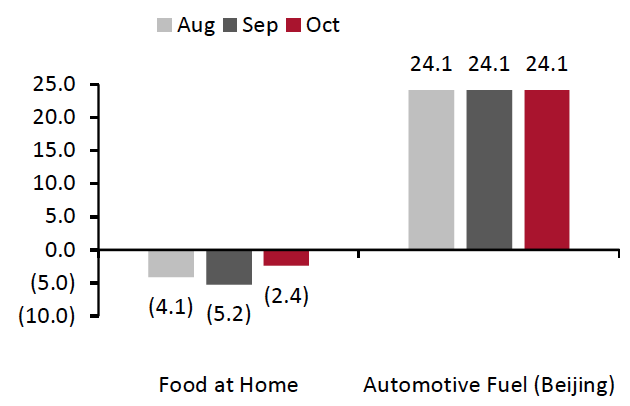
albert Chan
US
|
What’s New? |
Trend Data |
Positive or Negative* |
|
Earnings vs. Inflation: In the US, seasonally adjusted inflation accelerated to a 31-year high at 6.2% in October, mainly due to volatile food and gas prices. Nominal wage growth remained at 4.6% year over year in October. With inflation outpacing wage growth, US consumer sentiment has declined to a 10-year low as of early November. In October 2021, average hourly earnings rose by $0.11 to $30.96, remaining in line with the $0.12 rise in September. Average weekly hours ticked down in October slightly to 34.7, from 34.8 in September. In October, the seasonally adjusted unemployment rate dropped to 4.6%—well below the 5.0% level that economists typically consider to represent full employment. Improvements were seen in the leisure and hospitality, business and professional services, manufacturing, and transportation and warehousing sectors. Retail posted an addition of 35,000 jobs this month, but remains 140,000 jobs lower than its February 2020 pre-pandemic level. In the week ended November 13, 2021, approximately 268,000 Americans filed for unemployment benefits, a decrease of 1,000 from the previous week. |
Average Weekly Earnings vs. Consumer Prices: YoY % Change  |
|
|
Food and Fuel Prices: Food and gas price inflation rates are significant metrics because higher costs in these categories can impact discretionary spending. October saw US food inflation continue to accelerate for the sixth consecutive month. Gasoline price inflation has fluctuated over the last three months but remains very high, caused by a rapid recovery in demand and a tightening of global crude supply by the Organization of the Petroleum Exporting Countries (OPEC). On August 11, the office of US President Joe Biden requested that OPEC and its allies boost crude oil production to mitigate rising gasoline prices. Separately, in July, OPEC and its allies agreed to boost crude oil production by 400,000 barrels per day (bpd), starting in August, until bpd reaches pre-pandemic levels—the oil producers are currently supplying 5.8 million bpd fewer than before the crisis. On September 1, OPEC reaffirmed the 400,000 bpd supply boost in a meeting with its allies. On November 23, President Biden announced the administration will utilize the Strategic Petroleum Reserve (SPR). The US intends to release 50 million barrels of oil from the SPR in an attempt to combat the rapid rise in fuel inflation in 2021. |
Consumer Prices for Food at Home and Gasoline: YoY % Change 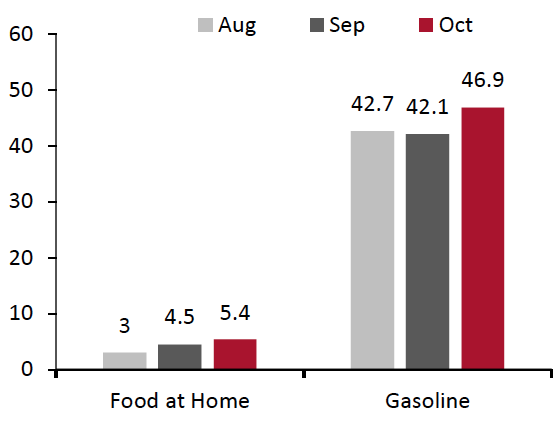 |
|
|
Retail Sales: Total US retail sales, excluding gasoline and automobiles, grew by a strong 10.8% year over year and by 23.2% compared to 2019 values. Many sectors saw strong sales growth in October 2021 compared to pre-pandemic October 2019: Sales increased by 38.7% at sporting goods, hobby, musical instrument and book stores, by 34.1% at nonstore retailers, by 31.2% at miscellaneous store retailers, and by 24.2% at general merchandise stores. US department store sales are continuing strong recovery, posting 17.6% two-year growth in October. |
Total Retail Sales ex. Automobiles and Gasoline: YoY % Change [caption id="attachment_136972" align="aligncenter" width="300"]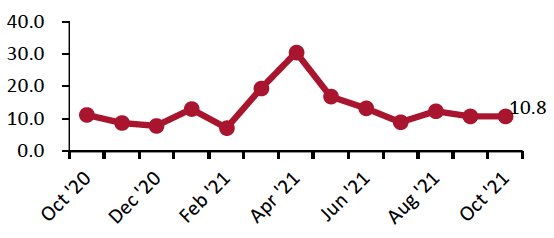 Data are not seasonally adjusted[/caption] Data are not seasonally adjusted[/caption] |
*Coresight Research’s evaluation of what the figure means for the state of the consumer economy Source: US Bureau of Labor Statistics/US Census Bureau/Coresight Research
UK
|
What’s New? |
Trend Data |
Positive or Negative* |
|
Earnings vs. Inflation: In the UK, inflation ticked up in October. Consumer prices grew 3.8% in October, an acceleration from September’s 2.9% growth. Average earnings growth decelerated for the fifth straight month in September to 4.4% (latest data), from 5.7% year-over-year growth in August. In October 2021, the number of payroll employees increased by 4.0% compared to October 2020, totaling an increase of almost 1.4 million employees. Month over month, the number of payroll employees increased by 160,000. In October, median monthly pay increased by 4.9% year over year, and by 7.8% when compared to pre-pandemic February 2020 median monthly pay. The administrative and support services sector saw the largest gains, adding 283,000 employees while the transportation and storage sector saw the largest decline of 14,000. |
Average Weekly Earnings vs. Consumer Prices: YoY % Change [caption id="attachment_136973" align="aligncenter" width="300"]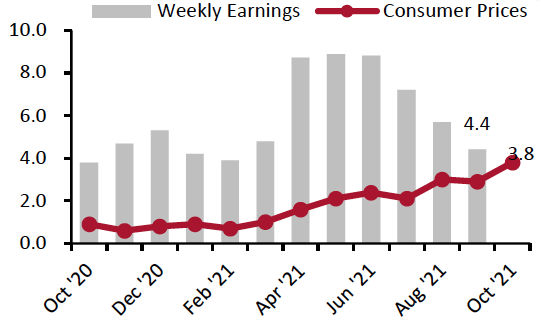 Latest earnings data are for September Latest earnings data are for SeptemberSource: ONS[/caption] |
|
|
Food and Fuel Prices: Higher costs for food and automotive fuel can impact discretionary spending. In October, UK food prices increased year over year for the third consecutive month—although the increase was small at 1.3%. Automotive fuel price inflation accelerated from September. Year over year, automotive fuel prices increased by 21.5%, the largest year-over-year increase in 2021 so far. |
Consumer Prices for Food at Home and Automotive Fuel: YoY % Change 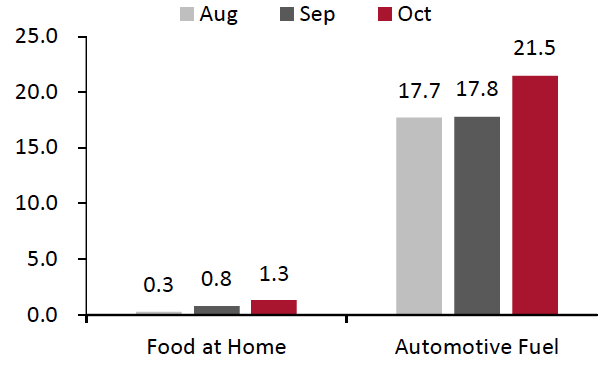 |
|
|
Retail Sales: Total UK retail sales growth continued to be slow in October, with just a slight gain of 0.7% year over year. However, on a two-year basis (versus pre-pandemic 2019), retail sales grew by a substantial 9.4%—an acceleration from September’s 6.4%. October marked the third month of two-year growth acceleration, casting a more positive light on retail sales growth in the UK. Clothing specialists’ sales posted strong gains in October, growing 18.0% year over year. In October, the clothing sector recovered to surpass pre-pandemic values for the first time, growing 1.9% on a two-year basis. The footwear sector has yet to recover to its pre-pandemic value, posting a two-year decline of 3.7%. Sales at department stores—which have been severely challenged during the pandemic—recovered to surpass pre-pandemic values with modest gains of 0.4% on a two-year basis. Health and beauty sales continued to see strong growth in October. Sales were up by 21.5% compared to two years prior. Online sales as a percentage of overall retail continued to grow in October, reaching 26.3%. Despite accounting for over one-quarter of all retail sales, online sales continued to see negative growth compared to October 2020, declining by 8.4%. |
Total Retail Sales ex. Automobiles and Automotive Fuel: YoY % Change [caption id="attachment_136975" align="aligncenter" width="300"]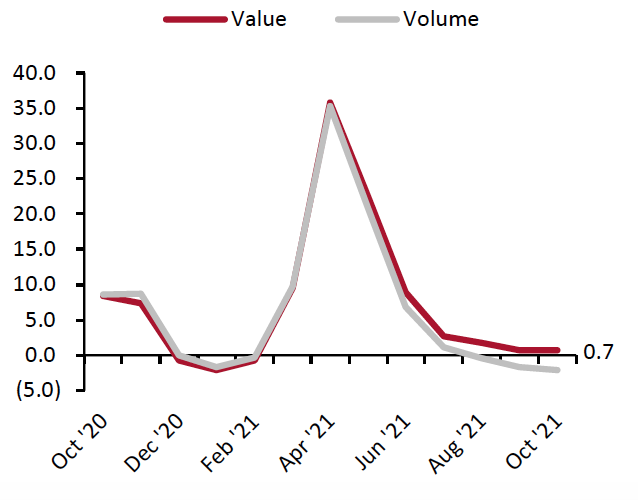 Data are not seasonally adjusted[/caption] Data are not seasonally adjusted[/caption]
|
*Coresight Research evaluation of the figure’s indication of the state of the consumer economy Source: Office for National Statistics/Coresight Research
China
|
What’s New? |
Trend Data |
Positive or Negative* |
|
Income vs. Inflation: In China, the consumer price index grew 1.4% in October, slightly up from September’s 0.7% rise in prices. Data on per capita disposable income are released quarterly. In the third quarter of 2021, per capita disposable income grew 10.4% year over year, down slightly from 12.6% growth in the second quarter of 2021 but still healthy. The economy’s recovery is being challenged by three key factors: a struggling real estate market as the government implements its newest five-year plan, natural disasters from earlier in the year affecting the supply chain and sporadic coronavirus outbreaks resulting in stringent local lockdowns. |
Per Capita Disposable Income vs. Consumer Prices: YoY % Change [caption id="attachment_136976" align="aligncenter" width="300"]  Disposable income data are quarterly[/caption] Disposable income data are quarterly[/caption] |
|
|
Food and Fuel Prices: Higher costs for food and automotive fuel can impact discretionary spending. In October, food prices in China decreased for the fifth straight month, although the declines eased. Food prices declined by 2.4% in October. Beijing’s fuel price inflation remained unchanged yet again month over month, standing high at 24.1%. |
Consumer Prices for Food at Home and Automotive Fuel: YoY % Change |
|
|
Retail Sales: Retail sales growth remains stuck in the low single digits, although growth has accelerated for the second consecutive month. In October, retail sales grew 5.2% year over year and 6.7% on a two-year basis. Apparel and footwear sales continued to decline on a year-over-year basis, falling by 3.3%, representing the third consecutive month of easing declines. However, on a two-year basis, apparel and footwear sales saw solid growth of 6.4%. This sector is likely impacted by China’s strict Covid-19 restrictions aiming to contain local outbreaks. Beauty sales continued to gain speed in October after a flat August, posting a 7.2% year-over-year sales growth in October, an acceleration from a 3.9% growth in September. On a two-year basis, beauty sales saw strong growth of 32.6%. Communication equipment had the strongest month of any sector for the second consecutive month. Sales grew 34.8% year over year and 50.9% on a two-year basis. Food retailers saw continued steady growth of 9.9% year over year or 14.0% compared to the same period in 2019. |
Total Retail Sales ex. Food Service, incl. Automobiles and Gasoline: YoY % Change [caption id="attachment_136978" align="aligncenter" width="300"]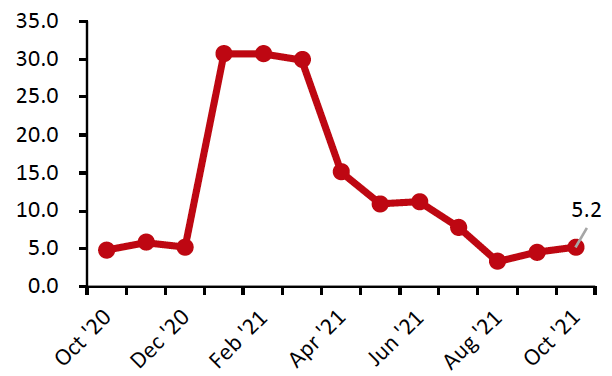 Data for January and February 2021 are aggregated.[/caption] Data for January and February 2021 are aggregated.[/caption] |
